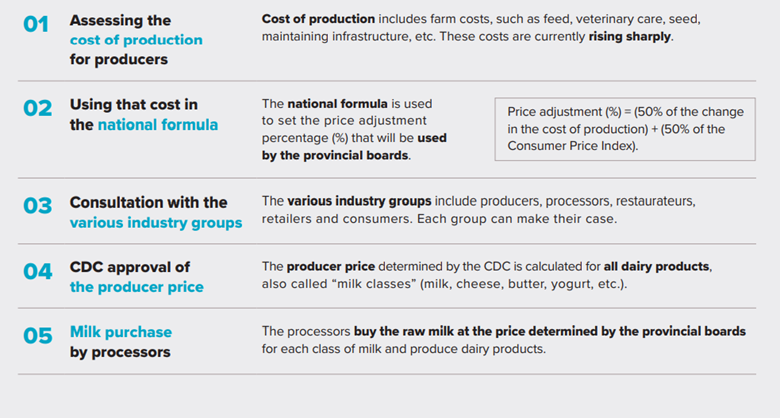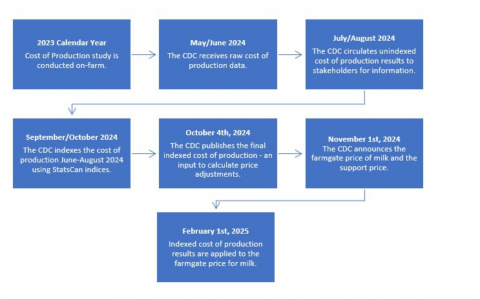-
Why is the price of milk at the farmgate regulated?
Regulating the price of milk is one of the elements of the supply management system for dairy. However, only the price of milk that farmers get is regulated. With the exception of fluid milk in some provinces, the retail price of dairy products is not regulated in Canada.
After the milk leaves the farm, it enters the market where supply, demand and other factors influence the price.
-
What is the process to determine the price that farmers get for their milk?

More detailed information on the process involved in setting the price of milk at the farm level is available here. Results of the annual cost of production survey are available here.
Image
On what data are price adjustments based?
The formula used to calculate price adjustments is based on a combination of the indexed cost of production for milk, the overall consumer price index in Canada, and other Statistics Canada indices. When the result of this formula does not reflect current market situation, stakeholders can request that the result of the formula be put aside and ask the Canadian Dairy Commission to make a decision on a price adjustment.
-
What is the goal of the Cost of Production (COP) survey?
The goal of the COP survey is to accurately measure the on-farm cost of producing a hectolitre of milk (100 litres). It accounts for both changes in the costs of farm inputs and productivity gains on farms.
There is a lag between the time the COP survey is completed and the time the COP is used in the pricing formula. To ensure the COP is representative of the time period in which it is applied, it is indexed using the latest available data. The indexed cost of production is then used for pricing purposes.
-
Why is the cost of production indexed?
The cost of production (COP) is used to calculate milk prices effective for the following February 1st. To ensure it reflects the current situation, the COP is indexed to August of the current year.
-
Who is consulted during the pricing process?
A series of stakeholders are invited to participate in consultations. They represent the entire supply chain and include the Canadian Federation of Independent Grocers, the Dairy Farmers of Canada, the Dairy Processors Association of Canada, the Retail Council of Canada, and Restaurants Canada.
-
When do pricing consultations take place?
Consultations take place in the fall prior to the following February 1st price adjustment.
-
When are new milk prices announced?
The CDC announces the price adjustment, if any, by November 1st of the current year at the latest. Provincial milk marketing boards then follow their own procedures to adjust milk prices for the various milk classes. These will be available in mid-December of the current year and will apply on February 1st of the following year.
-
Does the price of milk ever go down?
Yes. The adjustment to the price of milk is established using a formula that is based on the cost of producing milk and on the consumer price index, which is a measure of inflation. If these factors go down, then the price of milk can go down. This formula reduced the price of milk at the farm level slightly in February 2017 and 2018.
-
Which dairy products are impacted by an adjustment?
A price adjustment applies to the price that farmers get when they sell their milk. All dairy products can therefore be impacted although the effect for consumers may vary between products. The CDC only regulates the price of the milk that leaves the farm. The retail price is set all along the supply chain and is also affected by increases in costs such as transport.
-
How do price adjustments at the farm impact consumers at the retail level?
Price adjustments may have an impact on the retail price of all dairy products, although the size of the impact will depend on decisions of players along the supply chain regarding their own cost increases.
-
What is the support price for butter?
The support price for butter is used by the CDC when buying and selling butter under its Domestic Seasonality Program. This program allows the CDC to work with the private sector to balance the seasonal demand and supply of products for the domestic market. When milk production exceeds requirements for the Canadian market, the CDC buys butter from processors at the established support price. These stocks are later sold back to processors at the support price when demand increases.
-
What is a butter make allowance?
A make allowance (sometimes referred to as a processor margin) is an estimate of how much it costs to process milk into butter. It includes costs such as labour, packaging, energy, equipment and cleaning products.